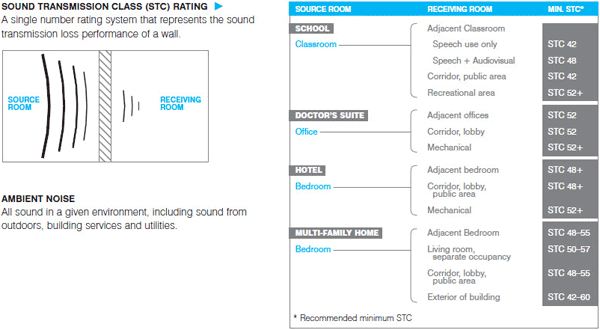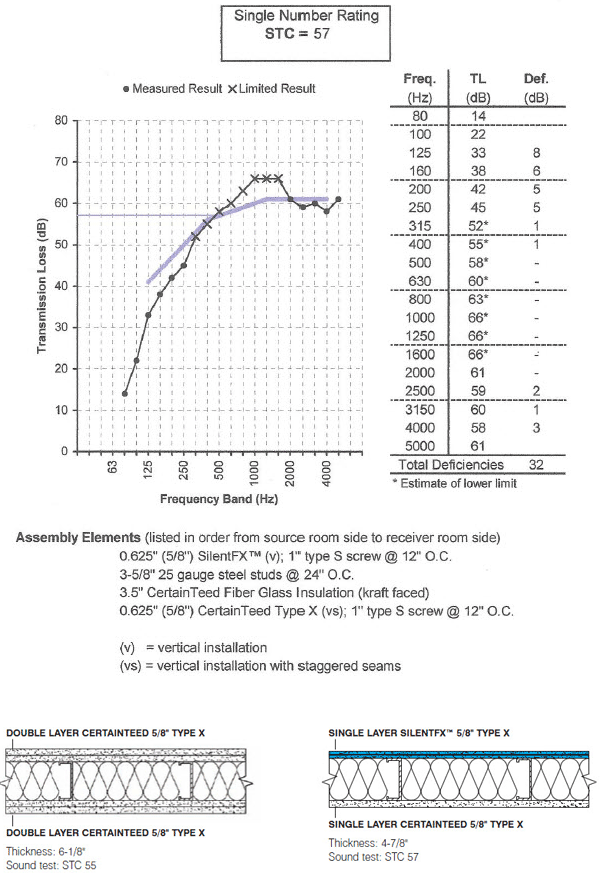Acoustical Control with Gypsum Board
Ambient Noise
All background sound in a given environment, including sound from outdoors, building services and utilities is generally referred to as ambient noise. It can also be generated from people talking or functioning in adjacent indoor spaces. A certain amount of this ambient noise in the background is certainly commonplace, but excessive background noise can seriously degrade the ability to communicate, thus making it more difficult for people to hear and speak without raising their voices. It is generally accepted that most people would need to speak at least 15 dB louder than the ambient noise level in order to be heard at all. Therefore, what might otherwise amount to a moderate sound level for conversation (40 – 60 dB), can get bumped up into the loud sound range (60 -80 dB) by trying to overcome background noise that is already in the moderate range. Hence it is generally preferred that ambient noise is limited to less than 40 dB in a space where conversation or speaking is taking place.
Sound Transmission Class
With the acceptable ambient noise levels thus established the building designers need to focus on how to achieve them by restricting unwanted sound from entering the spaces being designed. This means creating wall, floor, and roof components or assemblies that first effectively block the amount of airborne sound transmitted through them. The measurement for this effectiveness is determined by a Sound Transmission Class (STC) rating. A higher STC rating means that more airborne sound is blocked by the component or assembly. Lower STC ratings mean that more sound passes through the components or assemblies adding to the background noise level in the space, thus degrading the ability to hear and understand speech.
 |
Sound Transmission Class (STC) ratings are one common and important measure of acoustical performance with different ratings appropriate to different occupancy types. Image courtesy of CertainTeed Gypsum |
It should be noted that, contrary to the popular notion that airborne sound passes through a structural element, such is not exactly the case. Sound generated on one side of a wall will energize the wall structure and set it in motion, much like a diaphragm. The wall itself becomes the transmitter of the sound energy which can be heard on the opposite side of the wall by the listener. Hence, the ASTM test methods used to determine STC ratings have focused on this direct transmission process. Currently, the STC number is derived from sound attenuation values tested at sixteen standard frequencies from 125 Hz to 4000 Hz. These transmission-loss values are then plotted on a sound pressure level graph and the resulting curve is compared to a standard reference contour. Acoustical engineers fit these values to the appropriate Transmission Loss curve (TL) to determine a final STC rating. The measurement is accurate for speech sounds but less so for amplified music, mechanical equipment noise, transportation noise or any sound with substantial low-frequency energy below 125 Hz. As a supplement to STC ratings, Outdoor-Indoor Transmission Class (OITC) is a standard used for indicating the rate of transmission of sound between outdoor and indoor spaces in a structure that considers frequencies down to 80 Hz (Aircraft /Rail /Truck traffic) and is weighted more to lower frequencies.
 |
Actual test results show a single layer of 5/8” acoustical gypsum board achieves an overall STC rating of 57 compared to two layers of 5/8” gypsum board that achieves an STC rating of only 55 when all factors are equal. Images courtesy of CertainTeed Gypsum |









